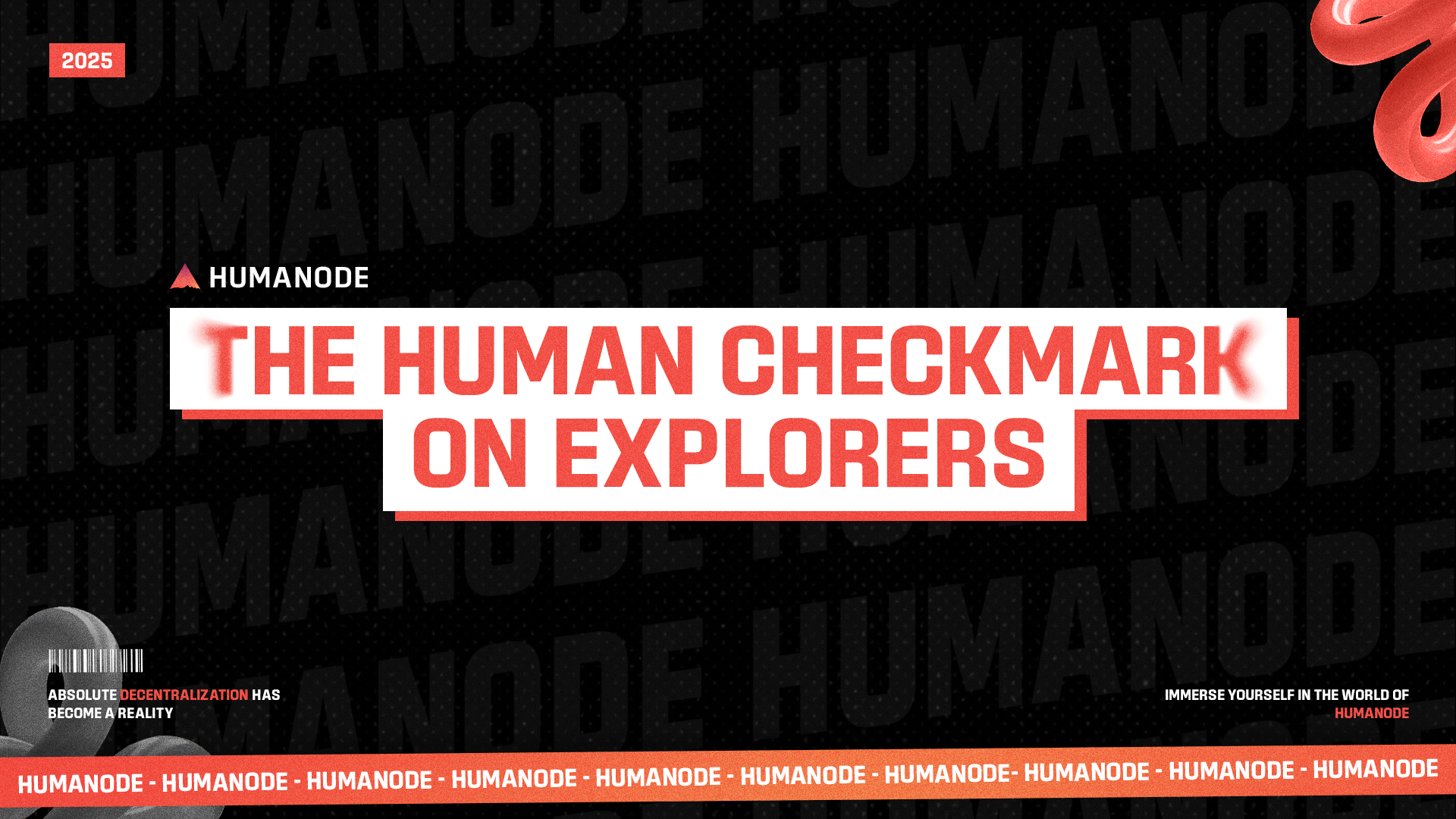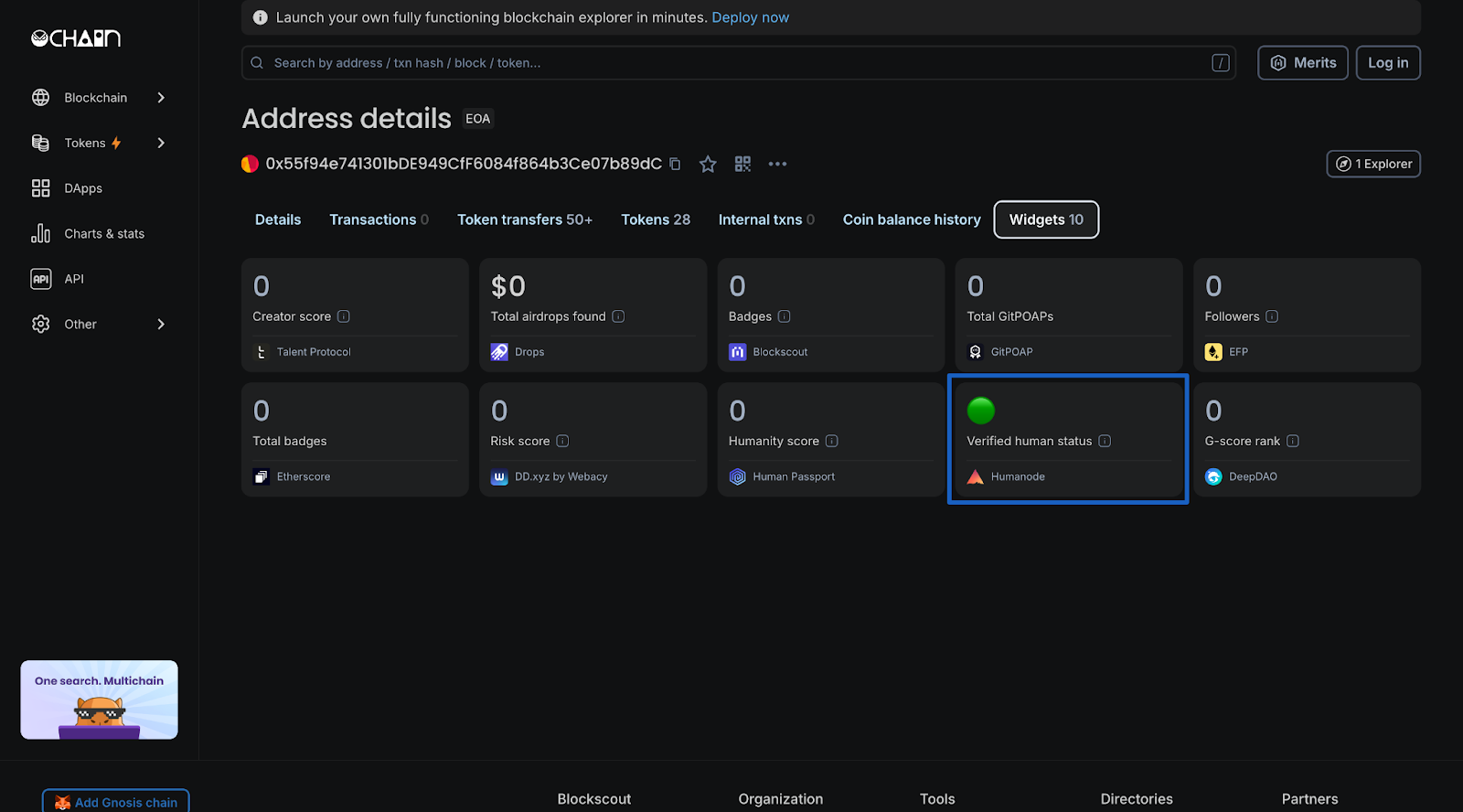One checkmark that’s changing the way we understand Onchain data

Blockchain explorers record everything: transactions, token transfers, gas spent, and wallets interacted with. And on a public chain, that data is transparent by design. That’s the revolution Web3 promised: open, traceable activity visible to anyone.
But there’s one thing even the best explorers can’t show you:
Whether the wallet you’re looking at belongs to a unique human being… or to a bot, or a multi-farming cartel running 100 wallets in parallel.
And in 2025, that’s not a small detail. It’s the missing piece that determines whether your growth metrics, governance votes, and airdrops are meaningful or completely gamed.
We’ve seen it play out over and over again.
A project announces an airdrop. Tens of thousands of wallets show up overnight. The campaign looks like a success, until the tokens are dumped, the Discord is flooded with alt accounts, and no one sticks around to use the product.
Or a DAO vote getting passed by thousands of addresses, but turning out to be coordinated by a single group. A new token hits 40k holders in a week… but then you check the activity and half the wallets are doing the same moves, within seconds of each other.
Explorers give us transparency on transactions, but not a uniqueness check. Not the intent.
They treat every wallet as equal. And that’s exactly how Sybil attackers win.
Now imagine if explorers could change that. What if you could actually see which wallets belong to real, unique humans?
Imagine scrolling through Etherscan and spotting a human checkmark next to a wallet address, knowing that it’s operated by a verified individual, not a bot farm or a coordinated wallet cluster.
Well, that’s not a thought experiment; it’s already happening.
Humanode’s Biomapper makes this possible with explorers like Verax (on Linea) and Blockscout, turning the idea of “onchain proof of uniqueness” into a visible, queryable reality.
Each wallet that completes biomapping gets a unique human checkmark, without revealing who they are. Yes, it’s not done by asking for your IDs or any personal data, just cryptographic proof that behind this address, there’s one real person.

Suddenly, transparency gains context.When your project claims 50,000 active wallets, you can now ask the better question:“How many are humans?”
And that shift, from counting wallets to counting people, might quietly become one of the biggest changes to how we read the data onchain.
What’s a Human Checkmark Anyway?
What does the “human checkmark” actually mean?
Let’s break it down.
Because it’s not just an icon. It’s a signal. A cryptographic confirmation that this wallet belongs to one unique human being. And that’s something blockchain has never had, at least not until now.
Here’s how it works behind the scenes:
It starts with a quick private face scan.
Not a selfie. Not a form. Just a liveness and uniqueness check which proves that you’re a real, living person in front of a camera. The same kind of tech used to stop deepfakes and bots, except in this case, you’re not verifying your identity, you’re verifying your uniqueness and liveness.
The verification happens inside a Confidential Virtual Machine (CVM): a locked-down, encrypted environment that even Humanode can’t access. It’s like doing a computation inside a black box. You don’t see in. You don’t pull data out. You just get a result.
And the result is a unique Biotoken: a kind of digital fingerprint (but not your fingerprint). It’s mathematically generated based on your facial features, encrypted inside the CVM, and linked to your EVM wallet address.
One person = one Biotoken = one wallet.
Importantly, this process is completely private. You can read more about the privacy part here.
You stay anonymous. But the network learns that your wallet is real and is not part of a botnet, or one of fifty in a farm.
Once biomapping is done, your wallet can now carry that proof, and you can bridge to any of the supported EVM chains.
It’s not stored inside the wallet like a token. It’s recorded in a smart contract, publicly verifiable, and accessible through explorers like Blockscout.
Here’s where it gets interesting.
When you search for a wallet on Verax or Blockscout, you’ll now see a visual human checkmark in the widgets.
Which means you can now tell, at a glance, whether the wallet belongs to someone real.
And if you’re building anything onchain from DeFi to DAOs to airdrops, you can query the explorer and filter for verified human wallets in seconds.
You don’t need to integrate Biomapper into your app or run your own verification; you don't even have to write custom logic to flag Sybils.
The explorer does the work for you. It becomes an interface for human-level identity without violating privacy.
Why does the Human checkmark matter?
So what changes when you can tell whether a wallet belongs to a unique human, right from the explorer?
A lot more than people think. Think about how much money gets wasted on fake users.
Projects spend tens of thousands, sometimes millions, on token incentives, hoping to grow real communities. But when half the “users” are one person with 20 wallets, that money doesn’t just go to waste. It distorts your metrics, inflates your CAC, and creates exit pressure from people who were never planning to stick around.
That’s not just a Sybil problem. It’s a capital efficiency problem.
But if you're distributing tokens or rewards and can filter for wallets that are provably human, your budget goes further. Your token stays in stronger hands. Your community retention improves. And your metrics start to mean something again.
Even things like staking, lending, farming, and points systems benefit from this. Right now, most DeFi protocols have no idea if the top 50 wallets in a pool are 50 users or one guy with scripts. But when explorers expose which wallets are real, protocols can start rewarding participation more intelligently, not just based on volume, but based on uniqueness.
It also opens up something bigger: reputation-backed wallets.
A wallet with a human checkmark isn’t just Sybil-resistant; it’s trusted. Not in a KYC’d, docs-on-file way. But in a way that says: “This address belongs to a unique person who’s playing fair.” And in Web3, that kind of trust can be used as capital.
You might get access to exclusive mints, better DAO roles, higher voting power, or custom yield curves. Airdrops might prioritize human-verified wallets. Identity layers like Lens, Farcaster, and Gitcoin could plug in the explorer flag and build on top of it. Over time, being verified as a human starts to carry real, compounding value across ecosystems.
And the best part? That reputation is portable.
If you are biomapped, your wallet verified on Linea doesn’t lose its checkmark when it moves to Gnosis. If a user maps once, they can carry that proof into any chain or dApp that supports the flag. You’re no longer building trust from scratch in every new ecosystem. You bring it with you.
So while explorers showing “isUniqueHuman” might feel like a small UI update… it quietly shifts the economics of trust across Web3.
In a space full of fast exits, fake growth, and wallet farms, one human-verified wallet becomes the most honest signal you can anchor your protocol to.
We’re used to thinking of explorers as passive tools. They show you blocks, addresses, tokens, and logs. They don’t care who is behind the data; they just display it.
But that’s exactly what’s changing.
When Verax and Blockscout integrated Biomapper, they stopped being just viewers of activity. They became human-aware interfaces. They started doing for blockchains what BotBasher does for Discord and Telegram apps, tagging who’s human and who might not be.
If you’ve ever used BotBasher on Telegram or Discord, you know the feeling. A user gets a linked role next to their name. You instantly know they’re not a throwaway account, not part of a bot swarm, not someone trying to game the community. It’s a tiny piece of context, but it changes how you engage with them.
This is the same idea, applied to onchain activity.
Now, when you’re reviewing wallet interactions on Verax or Blockscout, you’re not just seeing what, but you’re getting a hint of the who.
You can scan a list of voters, claimers, or minters and immediately spot which ones have been biomapped. You can see which side of a DAO proposal had more verified people backing it. You can check if the top 10 LPs in your pool are real users or one guy playing puppeteer with 10 wallets and a few bots.
You don’t need a full identity system. You don’t need biometrics in your app. You don’t even need to know who someone is. You just need to know if they’re real and unique.
That’s what Biomapper gives you. And when explorers surface that signal, it becomes part of the default onchain experience.
So yeah, it’s a small addition on the surface, just a checkmark next to a wallet address. But it shifts how we understand what’s happening onchain. It adds just enough context to cut through the noise. And now that explorers are starting to surface that signal, it’s a whole lot easier to build for real humans instead of bots and copy-paste farms.
Imagine if this were on Etherscan. You check a whale wallet, and instantly know whether it’s one person or a front for a farming cartel. You look at a DAO vote and see how much of it came from verified humans. You run an airdrop campaign and don’t have to guess who’s real. That tiny checkmark would quietly change how we read, measure, and design everything onchain.
Useful resources:

